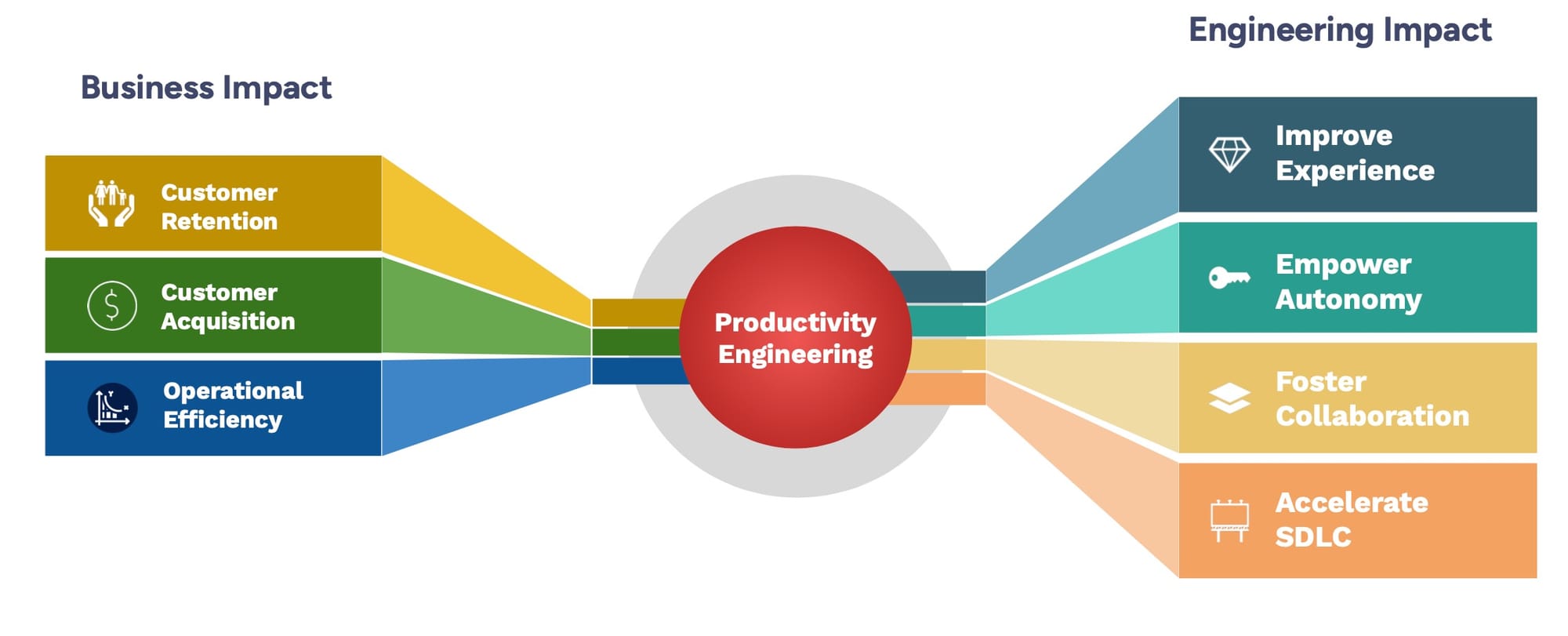Productivity Engineering: Driving Efficiency, Quality, and Growth

In today's fast-paced software development landscape, Productivity Engineering is a crucial discipline that ensures development teams can deliver high-quality software efficiently. Organizations that invest in Productivity Engineering gain a competitive advantage by accelerating feature delivery, improving system reliability, and enhancing developer satisfaction.

Engineering Productivity Driving Business Impact
Productivity Engineering is not just about improving developer efficiency—it directly contributes to business success. By investing in engineering productivity, organizations can achieve the following key business outcomes:
Business Impact
- Customer Retention: Reliable, high-quality software fosters customer trust, leading to long-term customer loyalty and reduced churn.
- Customer Acquisition: Faster time-to-market and enhanced product quality improve customer acquisition rates by delivering products that meet market demands.
- Operational Efficiency: Streamlined development processes reduce costs, optimize resource utilization, and free up teams to focus on innovation.

Engineering Impact
- Improve Experience: Providing world-class developer tools and workflows enhances the developer experience, making engineering teams more efficient and satisfied.
- Empower Autonomy: Self-service platforms and automated workflows empower developers to take control of their processes without external dependencies.
- Foster Collaboration: Cross-team collaboration is improved through standardized workflows, shared tooling, and seamless communication channels.
- Accelerate SDLC: Faster builds, automated testing, and streamlined CI/CD pipelines accelerate the software development lifecycle, enabling quicker feature releases.
Why Productivity Engineering Matters
- Faster Time-to-Market – A well-established Productivity Engineering function reduces development bottlenecks, enabling teams to ship features faster. This leads to increased revenue, as businesses can capitalize on market opportunities quicker than their competitors.
- Higher Code Quality & Reliability – Through rigorous automated testing, CI/CD quality gates, and predictive issue detection, Productivity Engineering helps teams minimize defects and maintain a high level of software reliability.
- Improved Developer Efficiency – By reducing cognitive load, automating repetitive tasks, and providing self-service environments, developers can focus more on building features rather than troubleshooting infrastructure issues.
- Increased Operational Efficiency – Optimized workflows lead to reduced operational costs by minimizing downtime, optimizing resource utilization, and automating redundant processes.
- Better Developer Satisfaction & Retention – Developers thrive in an environment where they can be productive without constant friction. Investing in Developer Experience ensures engineers feel empowered, reducing burnout and attrition.

The Four Pillars of Productivity Engineering
Productivity Engineering consists of four core groups that form the foundation of a highly efficient and scalable development process:
1. Quality Engineering – Ensuring Software Reliability
Core Responsibilities:
- Test Automation Strategy & Implementation: Develop, maintain, and enhance automated test suites to improve test coverage and reduce manual testing efforts.
- CI/CD Pipeline Quality Gates: Implement automated quality checks within CI/CD pipelines to ensure that only high-quality code is deployed.
- Performance Testing: Conduct load, stress, and performance testing to ensure applications meet scalability and response time requirements.
- Quality Metrics & Monitoring: Establish and track key quality metrics, including defect density, test pass rates, and defect leakage rates.
- Risk-Based Testing Prioritization: Use data-driven methods to prioritize testing efforts based on impact and risk analysis.
- Continuous Monitoring & Improvement: Implement real-time monitoring systems to proactively identify and address quality issues before they impact users.
Key Outcomes:
- Reduced defect leakage to production
- Increased test coverage and efficiency
- Reliable and stable software releases
- High detection rate of defects before production
2. Platform Engineering – Encompassing CI/CD, IDP (Internal Developer Platform), and Self-Service Capabilities
Core Responsibilities:
- CI/CD Implementation & Optimization: Develop, maintain, and enhance CI/CD pipelines to enable faster and more reliable software delivery.
- Internal Developer Platforms (IDP): Build and maintain developer platforms that provide a seamless development experience, reducing cognitive load and context switching.
- Self-Service Infrastructure Automation: Enable developers to provision and manage their environments through self-service automation, reducing dependency on operations teams.
- Optimizing Development Environments: Streamline and enhance development environments to reduce setup time and improve productivity.
- Standardized Workflows: Implement best practices for development workflows, ensuring consistency, reliability, and efficiency.
- Collaboration & Knowledge Sharing: Foster a culture of knowledge sharing by implementing internal documentation, developer wikis, and technical forums.
Key Outcomes:
- Faster developer onboarding
- Reduced time-to-first-commit
- Improved collaboration and knowledge sharing
- Improved development velocity
3. Developer Experience – Empowering Engineers
Core Responsibilities:
- Developer Toolchain Management: Standardize and manage the suite of tools used across development teams to improve efficiency and integration.
- Automating Repetitive Developer Workflows: Identify and automate common developer tasks such as dependency management, code linting, and test execution.
- Reducing Cognitive Load for Engineers: Simplify workflows and reduce unnecessary complexity to allow developers to focus on solving business problems.
- Enhancing Feedback Loops: Improve visibility into build, test, and deployment processes to provide real-time feedback to developers.
Key Outcomes:
- Enhanced developer experience
- Reduced setup time from days to hours
- Increased code deployment frequency
4. Technical Solutions Engineering – Enhancing Support and Driving Custom Solutions
Core Responsibilities:
- L3 Troubleshooting & Bug Fixes: Diagnose and resolve complex support tickets, minimizing escalations to Core Engineering (L4).
- Custom Solutions Development: Create customer-specific solutions, product extensions, and automation tools to enhance productivity.
- Bridging Customer Support & Engineering: Act as the key technical liaison between L1/L2 support teams and Core Engineering (L4) to optimize issue resolution.
- Process Optimization & Data Insights: Surface key support data, improve operational workflows, and enhance the efficiency of technical support teams.
- Knowledge Sharing & Training: Mentor and train support and development teams to improve technical expertise and operational effectiveness.
Key Outcomes:
- Faster resolution of technical issues, reducing impact on customers
- Increased efficiency in handling and categorizing support tickets
- Development of tailored customer solutions to improve retention
- Reduced dependency on Core Engineering (L4), allowing them to focus on product innovation

How the Four Pillars Drive Business Success
Each of these four pillars plays a crucial role in delivering measurable business impact:
- Quality Engineering ensures that products meet high standards of reliability, reducing production defects and improving customer satisfaction.
- Platform Engineering accelerates development and deployment cycles, enabling businesses to respond rapidly to market changes and customer needs.
- Developer Experience enhances engineering efficiency, leading to increased productivity, lower operational overhead, and faster innovation.
- Technical Solutions Engineering bridges customer support and core engineering, ensuring that customer issues are resolved efficiently and product extensions are developed to enhance value.
Together, these four pillars create a seamless, high-performance engineering ecosystem that translates into better business outcomes—faster time-to-market, increased revenue, improved customer retention, and optimized operational costs.
The Future: AI-Powered Productivity Engineering
As organizations scale, AI is becoming a key enabler of next-gen Productivity Engineering. AI-driven solutions are revolutionizing software development, allowing teams to deliver faster, more reliable, and higher-quality products. Some key areas where AI is making an impact include:
- Automated Code Generation & Refactoring: AI-powered pair programming assistants provide real-time suggestions, automatically refactor code, and improve development efficiency.
- AI-Driven Testing & Bug Detection: AI enhances test automation by generating test cases, prioritizing tests based on risk, and detecting anomalies before they reach production.
- Intelligent Monitoring & Observability: AI-driven log analysis, anomaly detection, and predictive maintenance help identify issues before they become critical, reducing downtime and improving software reliability.
- Smart Release Management: AI-powered feature flagging, A/B testing, and automated rollback strategies ensure controlled and risk-free deployments.
- AI-Powered Developer Experience: AI chatbots and virtual assistants streamline developer workflows, automate repetitive tasks, and provide instant access to documentation and knowledge bases.
- Predictive Analytics for Engineering Performance: AI models analyze historical engineering data to provide insights on productivity trends, optimize resource allocation, and improve sprint planning.

AI-driven Productivity Engineering enhances software development by automating repetitive tasks, improving code quality, and optimizing workflows. It accelerates time-to-market through automated coding and CI/CD pipelines, reduces defects with AI-driven testing, and boosts developer efficiency by minimizing manual tasks. Additionally, AI-powered observability prevents costly downtime, while predictive analytics provides actionable insights for better decision-making.
The integration of AI in Productivity Engineering is not just a trend, but a necessity for organizations that aim to stay competitive, innovate faster, and deliver high-quality software with reduced effort.
Conclusion
Productivity Engineering is a strategic necessity for modern organizations.
By investing in Quality Engineering, Platform Engineering, Developer Experience, and Technical Solutions Engineering, companies can build a scalable, high-performance engineering culture that accelerates innovation and delivers superior business outcomes.
Furthermore, the integration of AI in the Software Development Lifecycle (SDLC) is redefining how software is designed, built, tested, and deployed. AI-powered solutions are enhancing productivity at every stage of the SDLC, from intelligent code generation to predictive analytics for engineering efficiency.
The future of software development is driven by intelligence, automation, and efficiency. Productivity Engineering - augmented by AI - is the foundation for this transformation, enabling organizations to innovate faster, optimize costs, and maintain high-quality software at scale.

Comments ()